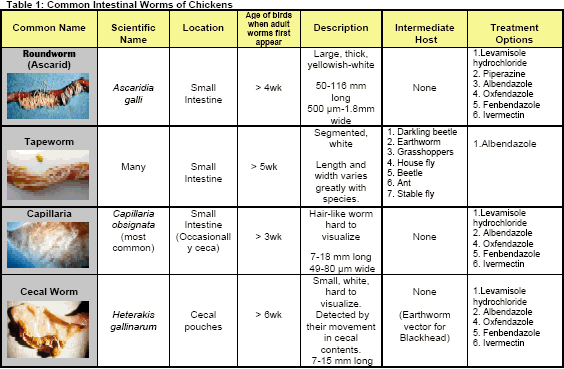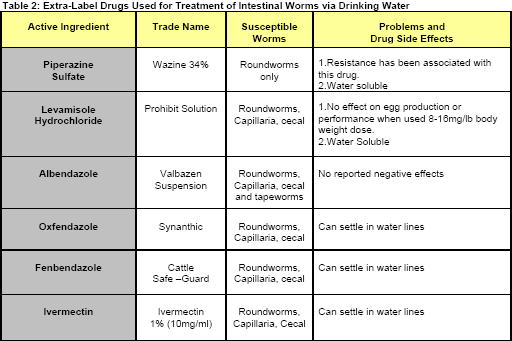



Treatment of Intestinal Worms In Broiler Breeders
Summary Provided by Dr. Suzanne Young, Aviagen and Dr. James Dawe, Bayer Animal Health - In recent years, all FDA approved intestinal worm treatments administered in poultry feed have been withdrawn from the US market. This left the industry dependent on piperazine, the only water administered deworming drug approved for poultry.Treatment of Intestinal Worms In Broiler Breeders - Summary Provided by Dr. Suzanne Young, Aviagen and Dr. James Dawe, Bayer Animal Health - In recent years, all FDA approved intestinal worm treatments administered in poultry feed have been withdrawn from the US market. This left the industry dependent on piperazine, the only water administered deworming drug approved for poultry. 
Piperazine is commonly used in both preventative and treatment programs. Due to widespread usage of piperazine, the industry suspects worms are building some resistance against this drug, possibly resulting in more intestinal worm outbreaks.
Intestinal worms are commonly diagnosed during necropsy of pullets, cockerels and occasionally broilers. A preventative worming program is suggested in rearing breeders to reduce the incidence and severity of intestinal worms. Severe intestinal worm infestations can cause diarrhea, poor absorption of nutrients, and enteritis. Clinical signs commonly seen with intestinal worm infestations include rough feathering, retarded growth, pasty vents and pale birds. Worms can be carriers of infectious diseases, including Blackhead (Histomonas meleagridis), (see Aviagen Technical Update Vol: 2 for more information) which has been diagnosed more frequently in recent months.
Cleaning out houses and placing new litter with every flock will minimize exposure to intestinal worms. Not only do houses containing built-up litter harbor intestinal worm eggs that could affect the next flock, they also serve as a reservoir for darkling beetles that are associated as carriers for worm transmission. Although preventative programs are ideal, occasionally outbreaks will occur. Table 1 below describes the most common intestinal worms in chickens; Table 2 summaries treatment options.

Piperazine is the only FDA approved drug for treatment of roundworms in poultry. Currently, there are no approved drugs for treatment of Capillaria, tape or cecal worms in poultry. As a result, the drugs below (other than Piperazine) are used extra-label in drinking water when prescribed and monitored by a licensed veterinarian.
FDA prohibits extra-label drug use in feed; therefore all treatments must be administered via drinking water. Follow all manufacturer recommended doses. Consult your veterinarian for prescriptions and withdrawal times.

Helpful hints when calculating dosages
-
Calculate total body weight of flock (lbs)
-
Dose mg X (lb in flock) = Total mg for flock
-
Be sure active ingredient and dose are in the same unit. 1g = 1000 mg
-
Total grams needed for flock / grams active ingredient per package = # of packages for flock
Calculation example
-
A house with 9000, 5lb females and 900, 5.5 lb males:
-
9000 (5)+ 900 (5.5) = ~49,950 total lbs in flock
-
-
If the dose is 16mg/lb:
-
49,950 lbs X 16 mg = 799,200 mg total for house
-
-
To convert to grams: 799,200/1000 = 799.2g
-
If there are 544.5g of active ingredient per packet:
-
799.2g needed / 544.5g active ingredient = ~1.5 packages for that flock
-
References
1. Dawe, J. and C.L. Hofacre, April 2002. With Hygromycin Gone, What are Today’s Worming Options? The Poultry Informed Professional: Issue 60; 1-8.
2. McDougald, L.R. 2003. Internal Parasites. In: Diseases of Poultry. Y.M. Saif (ed.) 11th ed. Iowa State University Press, Ames, IA:931-972.
Source: Aviagen - June 2005









